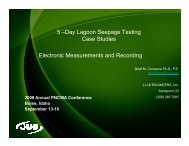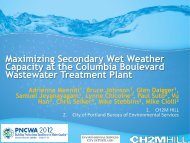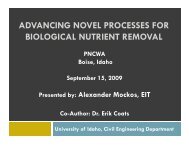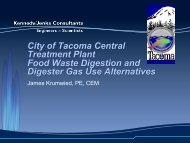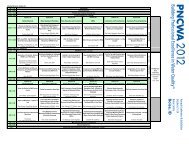Gasification of Sludge and Biosolids â A Review of ... - pncwa
Gasification of Sludge and Biosolids â A Review of ... - pncwa
Gasification of Sludge and Biosolids â A Review of ... - pncwa
Create successful ePaper yourself
Turn your PDF publications into a flip-book with our unique Google optimized e-Paper software.
PNCWA 2012Boise, ID<strong>Gasification</strong> <strong>of</strong> <strong>Sludge</strong> <strong>and</strong> <strong>Biosolids</strong> –A <strong>Review</strong> <strong>of</strong> Technology Fundamentals<strong>and</strong> the Current Commercial StatusOctober 24 | 2012
Agenda• Background• Process Fundamentals• Types <strong>of</strong> Gasifiers• Commercial Status• Energy Balances• <strong>Gasification</strong> Relative to Today’s Issues• Summary2
Background – History <strong>of</strong> <strong>Gasification</strong>• Charcoal formation (pyrolysis)• Several thous<strong>and</strong> years old• <strong>Gasification</strong>• Large scale use on coal in the 1800’s; wood in 1900’s• New focus → alternative feedstocksEPA, U.S. (2012). Technology Assessment Report: Aqueous <strong>Sludge</strong> <strong>Gasification</strong> Technologies.3
Process FundamentalsGeneral Steps1. Drying2. Pyrolysis (volatilization)3. Combustion (oxidation)4. <strong>Gasification</strong> (reduction)Main Types <strong>of</strong> Gasifiers• Fixed bed• Fluidized bedHeatCarbonFeedstockTarsH 2CH 4CharPyrolysis Reactions4
Reaction PathwaysCombustion (Oxidation) Reactions<strong>Gasification</strong> (Reduction) Reactions5
Heating MethodsFeedstock Combustion:Char + Limited O 2 → CO 2 + CO + H 2 O + HeatExternal Heat Sources:Induction Heater (Pyromex)Plasma Torch (Westinghouse)6
Technologies – Fixed Bed GasifiersUpdraft Gasifier• Feed: 45-50% DS possibleDowndraft Gasifier• Feed: >80% DSCombustionZoneReductionZonehttp://www.uaex.edu/Other_Areas/publications/publications_list.asp7
Technologies – Fluidized Bed GasifiersBubbling Fluidized Bed• Feed: >85% DSCirculating Fluidized Bed• Feed: >85% DSSyngashttp://www.uaex.edu/Other_Areas/publications/publications_list.asphttp://www.cospp.com/articles/print/volume-10/issue-1/features/danishbiomass-gasification.html8
Feedstock Properties• Prefer undigested sludge• Higher volatile content <strong>and</strong> less ash preferredProximate Analysis <strong>of</strong> Various <strong>Biosolids</strong> FeedstocksParameter“Typical”Undigested<strong>Sludge</strong> 1“Typical”Digested<strong>Sludge</strong> 1 “Fresh Solids” 2Ash, % 25-30 40-50 5.5-8.5Volatile, % 65-70 40-50 86.3Fixed C, % 5-10 5-10 7.9HHV, Btu/lb 6,500-8,500 3,000-5,500 7,500-8,000Sources: 1. Stamford Waste to Energy Draft Report; 2. Gikas et al., 20119
Syngas Properties• Low energy content• 100-130 Btu/ft 3 typical (air-blown)• Biogas ~550 Btu/ft 3• Natural gas ~950 Btu/ft 3• Primarily CO <strong>and</strong> H 2• Usually highly diluted with N 2• Syngas conditioning requiredfor use in a gas engine• Thermal oxidation <strong>of</strong> syngasavoids gas cleaningExample SyngasComposition (v/v)Hydrogen = 9%Carbon monoxide = 14%Carbon dioxide = 20%Methane = 7%Nitrogen = 50%10
<strong>Gasification</strong> vs. Incineration<strong>Gasification</strong>• Drying required aspretreatment step• Designed to maximizefeedstock conversion to CO<strong>and</strong> H 2• Reducing environment• Limited oxygenIncineration• Drying not required aspretreatment step• Designed to maximizefeedstock conversion to CO 2<strong>and</strong> H 2 0• Highly oxidizing environment• Excess air11
<strong>Biosolids</strong> <strong>Gasification</strong> ConfigurationsTwo Stage <strong>Gasification</strong>• Syngas cleaning• Internal combustion engine• Produce electricity <strong>and</strong>recoverable heatClose-Coupled <strong>Gasification</strong>• No syngas cleaning• Syngas thermally oxidized• Heat recovery <strong>and</strong>/or powergeneration from flue gasWet <strong>Sludge</strong>Main Energy SinkExcess EnergyDewateringDrying<strong>Gasification</strong>SyngasUtilizationEnergy for Drying12
Dried<strong>Sludge</strong>Limited O 2orExternal HeatExcessO 2ThermalOxidationClose-Coupled <strong>Gasification</strong>Process HeatFlue GasTreatment<strong>Gasification</strong>SyngasTwo Stage <strong>Gasification</strong>StackAshSyngasCleaningInternalCombustionEngineProcess HeatElectricityStack13
Commercial Status• <strong>Biosolids</strong> gasification still in embryonic stages• Pilot-scale <strong>and</strong> demonstration facilities:• M2R/Pyromex – Emmerich, Germany (trials in 2010)• Nexterra – Kamloops, BC (trials in 2009)• Primenergy – Tulsa, Oklahoma (trials in 2008)• Tokyo Bureau <strong>of</strong> Sewerage – Kiyose, Japan (2005-2006)• Stamford Biogas – Stamford, CT (2008)• Full-scale installations:• Kopf – Balingen, Germany (2002-present)• Kopf – Mannheim, Germany (in commissioning phase)• MaxWest – Sanford, FL (September 2009-present)• Tokyo Bureau <strong>of</strong> Sewerage – Kiyose, Japan (July 2010-present)14
Kopf Full-Scale Installations• Capacity:• Balingen: 5.4 tpd• Mannheim: 13.7 tpdOriginal Balingen PlantRebuilt Balingen PlantDried <strong>Biosolids</strong> FeedPhotos courtesy <strong>of</strong> Kopf15
Process Diagram for Kopf <strong>Gasification</strong> Plant16
MaxWest Full-Scale Installation• Capacity: 80 tpd (wet)• Owned <strong>and</strong> operated byMaxWest• Dryer requires somesupplemental natural gas<strong>Biosolids</strong> DryerUpdraft Gasifier (Gen #1 Unit)Thermal OxidizerPhotos Courtesy <strong>of</strong> MaxWest17
Photos <strong>and</strong> Schematics <strong>of</strong> MaxWest SystemFluidized Bed Gasifier(Gen #2 Unit)Thermal OxidizerCycloneCourtesy <strong>of</strong> MaxWest18
Sanford Facility Process Flow DiagramCourtesy <strong>of</strong> MaxWest19
Staffing Requirements• Sanford facility staffing requirements• 6 full-time operators• Plant manager <strong>and</strong> administrator• Owned <strong>and</strong> operated by MaxWest• Now <strong>of</strong>fering gasification equipment as capital sale• Typical installed cost in the range <strong>of</strong> $7-10M20
M2R/Pyromex Demonstration Unit• 1 tpd demonstration unit• Solids from raw wastewaterscreening (after headworksscreens)• “Fresh solids” from 200-350 µmfabric screen filter• “Ultra-high temperaturegasification”• ~1150°C• No oxygenDewatered “Fresh Solids”UHT GasifierInduction CoilGikas et al., 201121
Syngas from “Fresh Solids”Rotary Fabric Fine Screen• Trials with solids fromAdelanto, CA WWTP• January <strong>and</strong> June <strong>of</strong> 2010• Syngas properties• CO = 31.5%• H 2 = 49.2%• CH 4 = 7.73%• CO 2 = 3.20%• 8.83% “unidentified gases”UHT GasifierGikas et al., 201122
Stamford, CT Waste to Energy Project• High electricity costs• $0.18/kwh• City identified need for up to 15 MW additional power• Proposed gasification system to generate electricity• 25 tpd (dry) facility• Produce 1-3 MW <strong>of</strong> electricity from syngas• 2007 - Thermal drying facility constructed• Pilot gasification facility• Trailer mounted fixed-bed updraft gasifier (0.53 tpd)• 2008 to 2009 - Full-scale trials with three vendors• Primenergy, Nexterra, Kopf23
Stamford Pilot Gasifier• <strong>Gasification</strong> pilot donated to UCONNfor research in March 2012…Fixed-bed Updraft ReactorTrailer Mounted <strong>Gasification</strong> Pilotwww.stamfordbiogas.com/Kappe%20<strong>Gasification</strong>%20for%20SF.pdfSimilar24
Stamford/Nexterra Current Status• “The public balked at the project's $40 million pricetag, <strong>and</strong> the WPCA board voted to kill the venture inearly 2010 after losing faith in its technical <strong>and</strong>economic feasibility.”Read more:http://www.stamfordadvocate.com/news/article/Waste-to-energy-remnant-donated-to-UConn-3431002.php#ixzz2AAK4RDIv25
Energy Balance Considerations• Net Energy = Energy Outputs –Energy Inputs• Main energy outputs• Electric power• Heat• Main energy inputs (parasitic loads)• Dryer• Blowers• Gasifier startup• Gasifier external energy needs• Induction heater, plasma torch, etc.• Syngas cleanupCourtesy <strong>of</strong> Huber26
Power Generation Options• Fuel cells – not currently used with syngas• Gas turbines – require minimum heating value <strong>of</strong> 450Btu/ft 3 <strong>and</strong> pressurization <strong>of</strong> syngas• Internal combustion engines – possible• Requires minimum heating value <strong>of</strong> ~140 Btu/ft 3• Still may need to blend with natural gasSyngasBlendedGasGas EngineElectric PowerEngine Exhaust Heat RecoveryNatural Gas(if needed)Engine Cooling Jacket Heat Recovery27
Energy Required for Drying• Thermodynamics• Typically 1,400-1,700 Btu/lb <strong>of</strong> water evaporated• Heat sources:• Natural gas, methane, propane, electric power• Recovered heat, waste heat• SolarFor a 25 dtpd drying facility:ScenarioEnergy Required(MMBtu/hr)25 dtpd gasification + thermaloxidation system could yieldapprox. 8-10 MMBtu/hrNatural Gas Cost($/yr)Power Cost($/yr)15% Solids Feed 17.4 $1,181,000 $2,006,00020% Solids Feed 12.2 $827,000 $1,404,00025% Solids Feed 9.0 $614,000 $1,043,000Assumes 1,500 Btu/lb water evaporated, 90% dry solids product, natural gas = 1,030 Btu/cf,natural gas =$8/1000-cf, power = $0.045/kWh28
Energy Balances Presented in Literature• 5 tpd two-stage gasification system (~4-6 mgd WWTP)• Energy balances NOT from actual full-scale operationAir-Blown Gasifier 1• Net output = 165 kW• Assumptions:• Syngas HHV = 190 Btu/ft 3• System parasitic load = 75 kW• <strong>Biosolids</strong> dried to 90% solidsM2R/Pyromex Gasifier 2• Net output = 295 kW• Assumptions:• Syngas HHV = 338 Btu/ft 3• System parasitic load = 116 kW• <strong>Biosolids</strong> dried to 78% solids• M2R also presented energy balances in recent paperfor a hypothetical 20 mgd WWTP (Noll, 2012)• Claimed net electrical energy output <strong>of</strong> nearly 2:1 vs.anaerobic digestion1. Source: US EPA, 2012; 2. Source: M2R Thermal Energy Conversion Brochure29
Energy Balances Presented in Literature• From Stamford Waste to Energy project report:• <strong>Biosolids</strong> feed rate = 3,695 lb/hr• Syngas production rate = 2,595 scfm• Syngas LHV = 117 Btu/scf• Quantity <strong>of</strong> syngas = 84,287 scf/ton-biosolids• Cold gas efficiency = 69.4%• Gross electric power production = 1,869 kW• Net electric power production = 1,623 kW• Proposed facility footprint <strong>of</strong> 140’x100’• Project killed due to cost <strong>and</strong> technical feasibility30
Energy Balances from OperatingFacilities• Kopf – Balingen plant• Digested sludge• Equivalent to approx. 7.2 mgd• Original plant used solar drying• Produced ~70 kW <strong>of</strong> electric power• 15 kW needed for parasitic loads• ~55 kW net• Produced ~140 kW <strong>of</strong> thermalenergy• Used to heat digesters at the WWTP• Rebuilt in 2006 – added belt dryer• Most <strong>of</strong> the gas now used forheating the belt dryerCourtesy <strong>of</strong> Kopf31
Energy Balances from OperatingFacilities• MaxWest facility in Sanford, FL• Main goal is an energy-neutral system• Current input to dryer is 16% solids• Needs to be dried to 90% solids• Current system requires natural gas supplement for dryer• According to MaxWest, achieving energy-neutralrequires:• 23-25% solids feed depending on ratio <strong>of</strong> primary/secondarysludge32
Economics <strong>of</strong> Two-Stage <strong>Sludge</strong> <strong>Gasification</strong>• Economics largely dependent on electricity cost• Renewable energy tariffCaseNational AverageWholesale Electricity RateNew Engl<strong>and</strong> AverageIndustrial Electricity Rate +RE Tariff ($0.0435/kWh)Electricity Cost, $/kWh $0.042 $0.093Tipping Fee, $/DT $70 $70Annual Operating Revenue, $ $41,624 $61,742Annual Operating Cost, $ ($36,995) ($41,551)Capital Costs, $ ($269,815) ($269,815)CAPEX per kW, $/kW $4,652 $4,652Payback Years 21 7Costs presented in USD per dry ton per day operating capacity; source: US EPA, 201233
Air Emissions Regulatory Requirements• Currently no specific EPA regulations• Case by case basis• May be classified as incinerators• Criteria air pollutants• Sulfur oxides (SOx)• Carbon monoxide (CO)• Nitrogen oxides (NOx)• Particulate Matter (PM)• Hazardous air pollutants• Hydrogen chloride (HCl)• Dioxins <strong>and</strong> furans (chlorinated organics)34
Air Emissions DataEmission Limits in 40 CFR Part 60 – Final Rule for SSIsPollutantUnitsExistingFB SSIsNew FBSSIsMaxWestGen #1 1MaxWestGen #2 2Cadmium (Cd) mg/dscm 0.0016 0.0011 0.0000723 -Carbon Monoxide (CO) ppmvd 64 27 7.87 16.1Hydrogen Chloride (HCl) ppmvd 0.51 0.24 1.8 0.321Mercury (Hg) mg/dscm 0.037 0.0010 0.00798 -Oxides <strong>of</strong> Nitrogen (NO x ) ppmvd 150 30 432.17 15.4Lead (Pb) mg/dscm 0.0074 0.00062 0.000819 -Dioxins/Furans ng/dscm 0.10 0.0044 0.0285 -Particulate Matter (PM) mg/dscm 18 9.6 9.6 8.23Sulfur Dioxide (SO 2 ) ppmvd 15 5.3 4.17 0.01. Source: US EPA, 20122. Source: data provided by MaxWest35
<strong>Gasification</strong> Relative to Today’s IssuesEnergy? Potential for energy generation(depends on syngas quality)- Drying required as apretreatment step- Heat recovery mostly used fordryingEmissions+ Reduced relative to incineration+ Lower air requirements+ Reducing environmentRegrowth/Reactivation+ Pathogens destroyed+ No biosolids to dispose <strong>of</strong>Resource Recovery+ POTENTIAL P recovery from ash- No N recoveryProcess Reliability- Four full-scale installationsworldwide- One full-scale installation in NorthAmerica36
Be Aware <strong>of</strong> the Process Cycle History…Development / No. InstalledThird Generation,Mature TechnologySecond GenerationFirst DemoTime<strong>Biosolids</strong> <strong>Gasification</strong>Anaerobic DigestionIncineration<strong>Biosolids</strong> DryingThermal HydrolysisSCWOFirst PilotFirst Applications37
38Questions?Courtesy <strong>of</strong> NexterraThank You!Courtesy <strong>of</strong> Kopf
References1. Judex, J., Gaiffi, M., Burgbacher, H. (2012). <strong>Gasification</strong> <strong>of</strong> dried sewage sludge:Status <strong>of</strong> the demonstration <strong>and</strong> the pilot plant. Waste Management, 32 (4),719-723.2. Gikas, P., Noll, S., Stedman, K. “<strong>Gasification</strong> <strong>of</strong> Primary Fine-Screened Solids forEnergy Production,” Eurasia Waste Management Symposium, Halic CongressCenter, Istanbul, Turkey, November 14-16, 2011.3. Mountouris, A., Voutsas, E., Tassios, D. (2008). Plasma gasification <strong>of</strong> sewagesludge: Process development <strong>and</strong> energy optimization. Energy Conversion <strong>and</strong>Management , 49 (8), 2264-2271.4. EPA, U.S. (2012). Technology Assessment Report: Aqueous <strong>Sludge</strong> <strong>Gasification</strong>Technologies. U.S. Environmental Protection Agency.5. Noll, S. (2012). A Net Energy Comparison <strong>of</strong> Anaerobic Digestion vs. Ultra-HighTemperature <strong>Gasification</strong> to Achieve Zero Energy, WEF Residuals <strong>and</strong> <strong>Biosolids</strong>2012.6. Li-ping, X., Tao, L., Jian-dong, G., Xue-ning, F., Xia, W., Yuan-guang, J. (2010). Effect<strong>of</strong> moisture content in sewage sludge on air gasification. J Fuel Chem Technol , 38(5), 615-620.39







